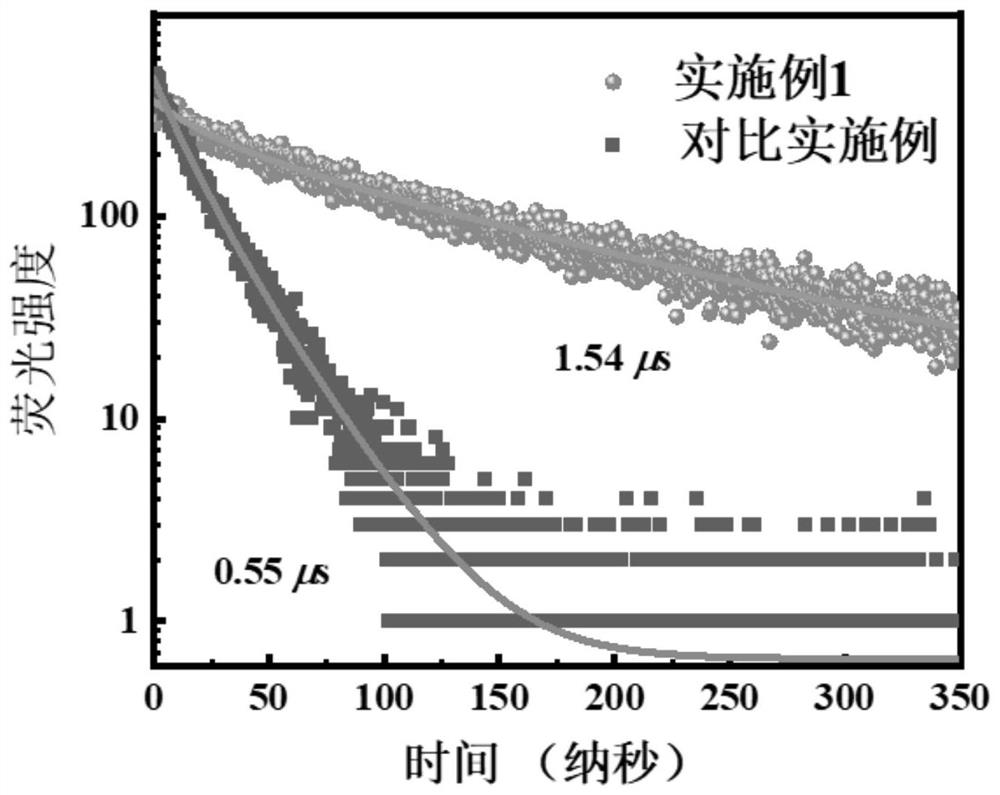Application of organic phosphonium salt molecule in perovskite solar cell and preparation method of device of organic phosphonium salt molecule
A technology of solar cells and phosphonium salts, which is applied in the field of compound preparation to achieve the effects of passivating interface defects, inhibiting non-radiative recombination, and improving power conversion efficiency and stability
- Summary
- Abstract
- Description
- Claims
- Application Information
AI Technical Summary
Problems solved by technology
Method used
Image
Examples
Embodiment 1
[0047] Prepare a positive perovskite solar cell modified by organic phosphonium salt molecule A, the specific preparation method is as follows:
[0048] (1) The ITO conductive substrate is ultrasonically cleaned with detergent, deionized water, acetone, and absolute ethanol in sequence, then dried with nitrogen, treated with ultraviolet ozone for 15 minutes, and cooled for later use;
[0049] (2) To 250 μL of SnO with a mass fraction of 15% 2 Add 750 μL deionized water to the nanoparticle dispersion, filter through 0.22 μm PVDF, take 40 μL dropwise onto the ITO conductive substrate treated in step (1), spin-coat at 3000 rpm for 30 s, and then anneal at 150 °C 30min, the electron transport layer was prepared, and then the electron transport layer was subjected to ultraviolet ozone irradiation treatment for 15min to prepare the electron transport layer;
[0050] (3) FAI (248.16mg), CsI (19.73mg), RbI (6.58mg), PbI2 (682.73mg), PbBr 2 (8.53mg), PbCl2 (12.74mg) and MACl (35mg) w...
Embodiment 2
[0071] Prepare a positive perovskite solar cell modified with organic phosphonium salt molecules B, the specific preparation method is as follows:
[0072] The difference from Example 1 is that in step (4), the organic phosphonium onium salt molecule A is replaced by the organic phosphonium onium salt molecule B.
[0073]
[0074] Figure 6 It is the current density-voltage graph of the perovskite solar cell in Example 2, and the photovoltaic parameters of the cell are obtained according to the graph, and the results are shown in Table 2.
[0075] The photovoltaic parameter of perovskite solar cell in the embodiment 2 of table 2
[0076]
[0077] Depend on Figure 6 It can be seen from Table 2 that the open circuit voltage of the perovskite solar cell in Example 2 is improved, and the power conversion efficiency is increased from 20.61% in the comparative example to 21.28%.
Embodiment 3
[0079] A positive perovskite solar cell modified with organic phosphonium salt molecules C is prepared, and the specific preparation method is as follows:
[0080] The difference from Example 1 is that in step (4), the organic phosphonium onium salt molecule A is replaced by the organic phosphonium onium salt molecule C.
[0081]
[0082] Figure 7 It is the current density-voltage curve graph of the perovskite solar cell in Example 3, and the photovoltaic parameters of the cell are obtained according to the graph, and the results are shown in Table 3.
[0083] The photovoltaic parameter of perovskite solar cell in the embodiment 3 of table 3
[0084]
[0085] Depend on Figure 7 It can be seen from Table 3 that the open circuit voltage and fill factor of the perovskite solar cell in Example 3 are improved, and the power conversion efficiency is increased from 20.61% in the comparative example to 21.28%.
PUM
| Property | Measurement | Unit |
|---|---|---|
| concentration | aaaaa | aaaaa |
| charge carrier lifetime | aaaaa | aaaaa |
Abstract
Description
Claims
Application Information
 Login to View More
Login to View More - R&D
- Intellectual Property
- Life Sciences
- Materials
- Tech Scout
- Unparalleled Data Quality
- Higher Quality Content
- 60% Fewer Hallucinations
Browse by: Latest US Patents, China's latest patents, Technical Efficacy Thesaurus, Application Domain, Technology Topic, Popular Technical Reports.
© 2025 PatSnap. All rights reserved.Legal|Privacy policy|Modern Slavery Act Transparency Statement|Sitemap|About US| Contact US: help@patsnap.com



